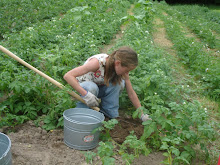
I sent out a survey to my CSA members again this year. Of the 54 surveys sent 20 came back (a good number I think!). Thanks to all of you who filled it out. I'm about ready to start planning the 2011 garden and these results will be helpful.
Here is how the survey went:
1) How did you feel about the tomatoes? Too many? Not enough? Did you have a favorite type or a kind you didn’t care for (Roma, Brandywine, Yellow Peach, Black Prince, Wisconsin 55, Red Cherry, Black Cherry, Sungold, Green Tomatoes)? Do you have a tomato variety suggestion(s)?
Here is how this question broke down:
Very much enjoyed all the cherry tomatoes = 2
Loved everything related to tomatoes = 11
Could’ve used even more cherries = 2
Had a few too many tomatoes in general = 6
Most folks thought the variety was good and didn’t really have a clear favorite or least favorite. Black Prince (ping pong sized purple cherry tomatoes) received two votes for most favorite tomato and Brandywine (large weird shaped pink tomato) received one vote. The yellow pear tomatoes received one least favorite vote.
I got a bunch of interesting suggestions about tomato varieties which I will be researching including: Green Zebra, Bushel Boy, Grape, Black Crim, Cherokee Purple and Yellow Pear Cherries.
2) Here is a list of new vegetables I tried this year: Kale, Soybeans, Garlic, Musk Melon, Sweet Potatoes, Shelling Beans ….what did you think of them? Do you have any suggestions on other new things to try?
And the survey says:
Didn’t like kale = 3
Liked kale = 7
Too much kale = 1
Impressed by soybeans = 1
Soybeans were too much work = 1
Didn’t care for soybeans = 3
Liked garlic = 8
Not impressed by musk melon = 5
Liked musk melon = 1
Disappointed with the sweet potatoes = 4
Liked the sweet potatoes = 2
Loved shelling beans = 2
Liked them all = 2
Hot peppers got two votes for something new for next year and cauliflower got one as did asparagus. One person thought they could’ve used fewer garlic scapes and more garlic heads. In regards to seeing more of things, eggplant, arugula, purple potatoes, cabbage, broccoli, shelling beans, green beans, carrots, corn and kale all received a vote or two.
3) In regards to herbs, half shares got basil, one round of fennel and a round or two of cilantro and dill. Full shares got quite a few more herbs. Generally speaking, did you think you got enough herbs? Do you have any suggestions on herbs that you would’ve liked to have seen in your box?
Grow their own and don’t need many or any = 3
Were generally happy with the herbs = 11
Had a hard time using them all = 2
Herb suggestions: tarragon, rosemary, mint, thyme, lemon thyme.
4) As far as eggs and flowers are concerned, I’m skeptical that our capability to produce these is plentifully enough to supply the CSA fully. Next year I’m seriously considering only running eggs and flowers to full shares only. Do you think this is a good idea?
Yes = 11
Reluctantly said yes = 8
5) What was your favorite CSA item? Your least favorite?
Most Favorite
sugar snap peas = 2
soybeans = 2
tomatoes = 4
kohlrabi
spuds = 4
garlic = 2
carrots = 3
watermelon
squash = 4
cherry tomatoes
beans = 3
broccoli
corn
kale = 3
pie pumpkins
early lettuce = 2
peppers
herbs
flowers
Least Favorite
Spaghetti Squash = 2
Turnips = 2
Green Tomatoes = 2
Kohlrabi
Swiss chard
Beets
Lettuce
Sunflower
Kale = 3
Summer squash
Tommatillos
6) Do you think you got a fair amount of produce for the price you paid for the share?
Eighteen people said yes to this question, two people were undecided. A couple of interesting points came up with this question. One person pointed out that the early and late season boxes were smaller than the midseason boxes (this is true, the season was a bell curve and oftentimes is). Another person would've liked to have seen more of fewer items in their box. In other words, less variety but bigger quanities...something to think about.
7) In addition to lambs, I had planned on raising a few pigs or cows this year and then offering the meat to CSA members. Unfortunately, by the time I got the hoophouse set up I felt I had run out of time. If I had raised some pork or beef would you have been interested in buying some?
Thirteen people said yes to this question. Six people said no (most of them were vegetarians).
8) Anything else you would like to add?
Ummmm, here is a sampling: “We enjoyed the box – a great supply”; “Thanks for all your hard work”; “Thanks for hosting the parties”; “Loved the pickle kit”; “Thank you for growing veggies for us again this year”; “Great experience for a first time CSA member”; “Thank you for feeding our family”; “Thanks! This was my first year trying out a CSA”; “Beets and onions”; “We loved the variety each week”; “Thanks for a great CSA program”; “Great job, thanks!”.



























